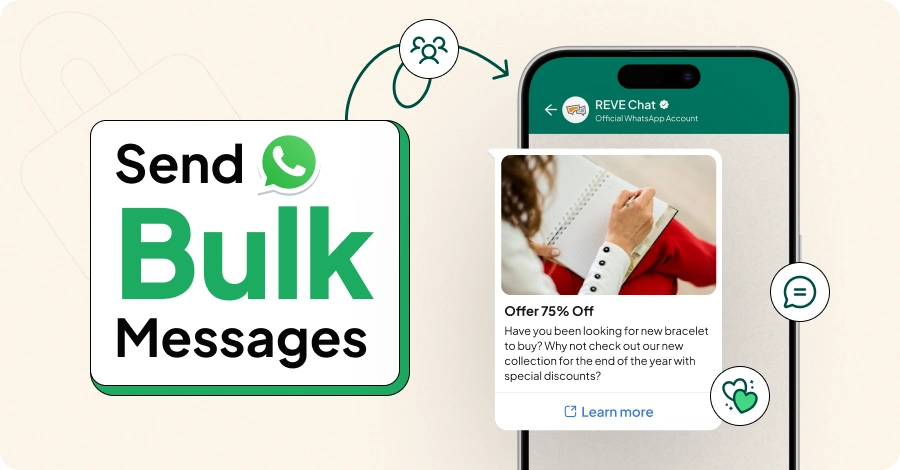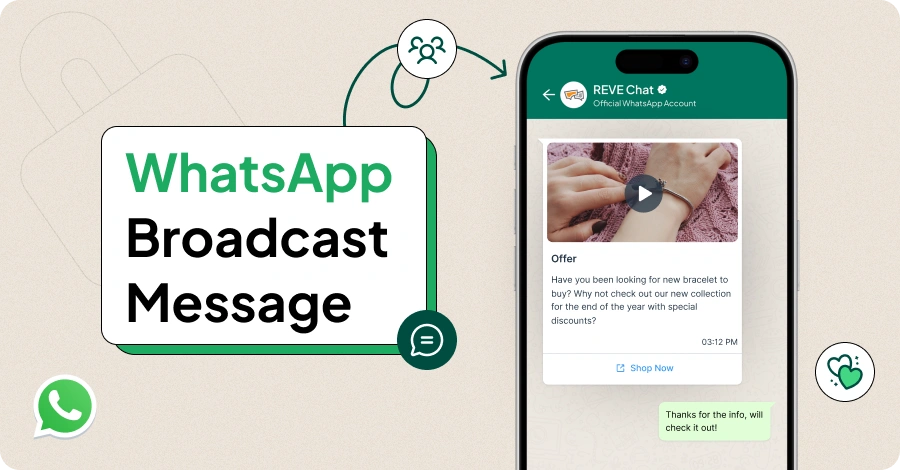Putting Customers First: A Guide to Customer-Centric Marketing
- October 11, 2023
- 14 mins read
- Listen

In the fast-paced world of marketing, the one constant that can make or break a business is the customer. It’s no secret that customers are the lifeblood of any organization, and in today’s hyper-competitive landscape, businesses are increasingly realizing the importance of customer-centric marketing.
Undoubtedly, it’s a strategic shift that has the power to transform the way businesses operate and connect with their audience.
Let’s explore the world of customer-centric marketing, exploring what it means, why it’s essential, and how it can revolutionize your marketing strategy.
What is Customer-centric Marketing?
Customer-centric marketing is like a well-crafted symphony, where every note and instrument is meticulously chosen to create a harmonious experience.
At its core, it is a strategic approach that orchestrates the entire marketing process around the desires, needs, and preferences of the customer. Imagine a grand tapestry where every thread is woven with the individual tastes and expectations of each customer, creating a seamless and personalized journey.
It’s a mindset that goes beyond mere transactions, nurturing enduring relationships where the customer takes center stage. In this symphony, data becomes the conductor’s baton, guiding marketers to make informed decisions, and customer feedback acts as the applause, encouraging continuous improvement.
Customer-centric marketing is a dance of empathy, where businesses not only understand but also resonate with the rhythms of their customers’ lives, delivering not just products or services, but meaningful and memorable experiences that leave an indelible mark.
Importance of Customer-Centric Marketing Strategy
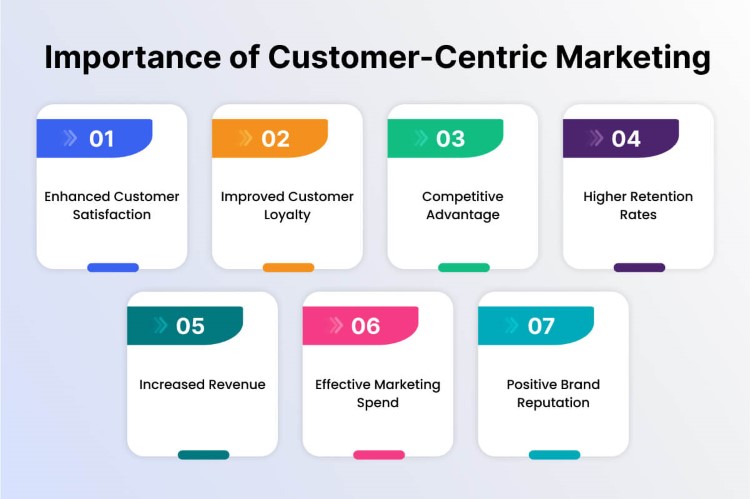
It is not just a buzzword; it’s a fundamental strategy that can have a profound impact on a business’s success. Here are several key reasons highlighting the importance of a customer-centric marketing strategy:
1. Enhanced Customer Satisfaction
By focusing on the needs and preferences of your customers, you’re more likely to deliver products, services, and experiences that align with their expectations. This leads to higher customer satisfaction levels, which can result in repeat business and positive word-of-mouth recommendations.
2. Improved Customer Loyalty
When customers feel valued and understood, they are more likely to remain loyal to your brand. Long-term customer relationships are often more profitable than constantly acquiring new customers, as loyal customers tend to spend more and refer others to your business.
3. Competitive Advantage
In a crowded marketplace, customer-centricity can be a significant differentiator. Businesses that prioritize their customers’ needs and provide exceptional experiences stand out from their competitors and are more likely to thrive.
4. Higher Retention Rates
Customer-centric marketing strategies help reduce customer churn rates. By continuously engaging and nurturing existing customers, you can minimize the need to replace lost customers with new ones constantly.
5. Increased Revenue
Satisfied and loyal customers tend to spend more with your brand. Cross-selling and upselling become more effective when you have a deep understanding of your customers’ preferences and needs.
6. Effective Marketing Spend
It allows you to allocate your marketing resources more efficiently. Instead of targeting a broad audience, you can focus your efforts and investments on the segments that are most likely to convert and provide the highest lifetime value.
7. Positive Brand Reputation
When customers have positive experiences with your brand, they become brand advocates. They are more likely to share their experiences on social media and review platforms, contributing to a positive brand reputation and attracting new customers.
The Key Elements of Customer-Centric Marketing Strategy
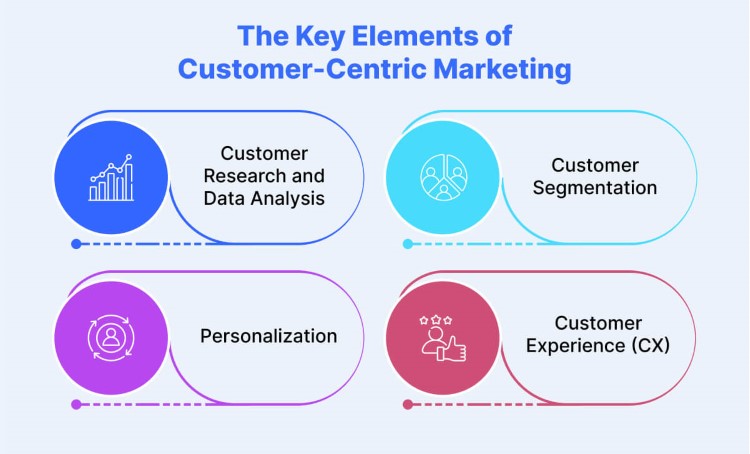
Customer segmentation allows for targeted full funnel marketing tactics, while personalization tailors those efforts to individual customers. Ultimately, providing an exceptional customer experience is the end goal, as it fosters customer loyalty, brand advocacy, and business success. It is about putting the customer first in every aspect of your customer-centric and integrated marketing strategy and operations.
1. Customer Research and Data Analysis
- Customer research involves gathering information about your target audience, which can include demographics, psychographics, preferences, and pain points.
- It refers to the process of examining and interpreting customer data, often collected through various channels like surveys, website analytics, and social media monitoring.
- Together, these activities help businesses gain a deep understanding of their customers’ behaviors, preferences, and needs.
- This information serves as the foundation for creating effective marketing strategies and personalized customer experiences.
2. Customer Segmentation
- It is the practice of dividing your customer base into distinct groups based on shared characteristics, behaviors, or preferences.
- By segmenting customers, businesses can create targeted marketing campaigns tailored to each group’s specific needs and interests.
- Segmentation allows for more efficient resource allocation, as marketing efforts can be focused on the segments that are most likely to convert or have the highest value.
3. Personalization
- It involves customizing marketing messages, product recommendations, and interactions to suit the individual preferences of each customer.
- This can be achieved by using customer data to deliver personalized emails, website content, product recommendations, and even personalized offers.
- Personalization enhances the customer experience by making individuals feel valued and understood, leading to increased engagement and loyalty.
4. Customer Experience (CX)
- It refers to the overall impression and interaction a customer has with a brand throughout their entire journey, from initial awareness to post-purchase support.
- Creating a positive CX involves optimizing touchpoints across all channels, including websites, mobile apps, customer support, and in-person interactions.
- A great CX leads to higher customer satisfaction, loyalty, and advocacy, as well as a competitive advantage in the market.
Crafting a Customer-Centric Marketing Strategy
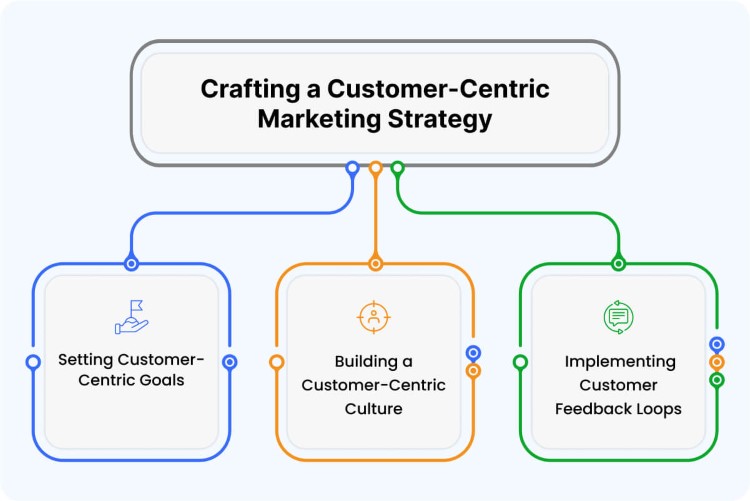
It involves putting your customers at the heart of your business by tailoring products, communication, and experiences to their preferences and needs. Let’s explore the vital steps to craft the result-driven strategy.
1. Setting Customer-Centric Goals
In the pursuit of a customer-centric marketing strategy, the first step is to establish clear and customer-focused goals. These goals should align with your understanding of customer needs and your overarching business objectives. Here’s how to do it:
- Align Goals with Customer Needs: Start by identifying the specific needs and desires of your target audience. What problems do they want to solve, and how can your products or services address these issues? Your goals should directly address these customer pain points.
- Measuring Success Metrics: Define Key Performance Indicators (KPIs) that help you track progress toward your customer-centric goals. These metrics might include customer satisfaction scores, Net Promoter Score (NPS), customer retention rates, or customer lifetime value. Regularly monitor and analyze these metrics to gauge your success.
2. Building a Customer-Centric Culture
It is crucial to ensure that every member of your organization is committed to prioritizing customers. It goes beyond just the marketing department; it should permeate every aspect of your company. Here’s how to foster such a culture:
- Employee Training and Empowerment: Train employees at all levels to understand the importance of customer-centricity. Encourage them to empathize with customers and empower them to make decisions that prioritize customer satisfaction.
- Embedding Customer-Centricity in Company Values: Incorporate customer-centric values into your company’s mission, vision, and values statements. Make it clear that customer satisfaction is a core organizational goal.
3. Implementing Customer Feedback Loops
Customer feedback is invaluable in fine-tuning your products, services, and marketing strategies to better meet customer needs. Implementing effective feedback loops ensures you’re continually improving based on customer insights:
- Gathering Customer Feedback: Establish channels for customers to provide feedback, whether through surveys, online reviews, or direct communication with customer support. Actively seek out and listen to this feedback.
- Acting on Feedback to Improve Products/Services: Analyze customer feedback to identify areas for improvement. Use this information to enhance your offerings, whether it’s modifying a product feature, refining customer service processes, or adjusting your marketing messaging.
By combining these three components, you create a robust customer-centric marketing strategy that not only sets customer-focused goals but also instills a company-wide culture that values and prioritizes the customer experience. Furthermore, the implementation of customer feedback loops ensures that your strategy remains adaptive and continually responsive to changing customer needs and expectations.
Customer-Driven Marketing Strategy Examples
Customer-driven marketing strategies focus on meeting customer needs. Let’s take a look at examples of two giant brands and how they developed their customer-driven marketing strategy.
Case Study 1: Amazon
Amazon, the global e-commerce giant, is renowned for its customer-centric approach, which has been a cornerstone of its success. Here are some key aspects of Amazon’s customer-centric marketing strategy:
- Personalized Recommendations: Amazon leverages sophisticated algorithms to analyze customer browsing and purchase history. This data is then used to provide highly personalized product recommendations to customers, increasing cross-selling and upselling opportunities.
- Customer Reviews and Ratings: It allows customers to leave detailed reviews and ratings for products. These user-generated reviews not only help prospective buyers make informed decisions but also provide valuable feedback to sellers and Amazon itself, enhancing the overall shopping experience.
- Prime Membership: Amazon Prime is a subscription service that offers various benefits, including fast and free shipping, streaming services, and exclusive deals. This program not only fosters customer loyalty but also encourages frequent purchases.
- Responsive Customer Support: Amazon places a strong emphasis on responsive and efficient customer support. Their “Customer Obsession” principle means they prioritize resolving customer issues quickly and to the customer’s satisfaction.
Case Study 2: Airbnb
Airbnb, the peer-to-peer lodging marketplace, has disrupted the hospitality industry with its customer-centric approach. Here’s how Airbnb’s strategy focuses on enhancing the customer experience:
- User-Generated Content: Airbnb encourages hosts and guests to leave reviews and ratings after each stay. These reviews provide valuable insights for both hosts and future guests, fostering trust and transparency in the platform.
- Tailored Search Results: It uses machine learning algorithms to personalize search results for users. It takes into account factors like past booking history, preferences, and location, ensuring that users see listings that are most relevant to their needs and interests.
- Instant Booking: To streamline the booking process and enhance convenience, Airbnb introduced the “Instant Book” feature, allowing guests to book accommodations without prior host approval, provided they meet certain criteria.
- Host Support and Education: It also offers extensive support and educational resources to hosts, helping them provide exceptional experiences for guests. This support includes host training, safety guidelines, and 24/7 customer support.
These case studies illustrate how Amazon and Airbnb have embraced customer-centric marketing to not only attract and retain customers but also to create thriving online marketplaces.
They prioritize customer feedback, personalization, and user-generated content to continuously improve their offerings and provide a superior customer experience.
Steps for Developing a Customer-Driven Marketing Strategy
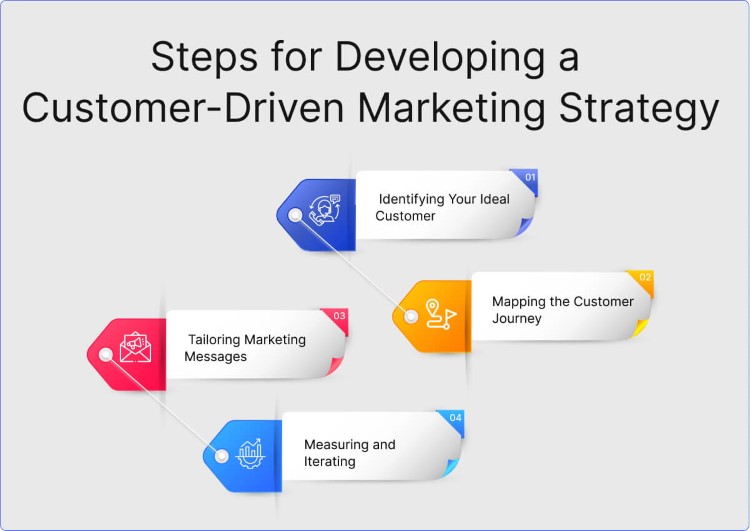
Developing a customer-driven marketing strategy involves understanding your audience, aligning with their needs, and continually adapting to ensure customer satisfaction and loyalty. Now let’s explore the key steps.
1. Identifying Your Ideal Customer
The foundation of a customer-driven marketing strategy is a deep understanding of your target audience. Here’s how to identify your ideal customer:
- Conduct Market Research: Start by conducting thorough market research to gather data on your industry, competitors, and potential customers. This research will help you identify market trends and customer segments.
- Create Customer Personas: Develop detailed customer personas that represent your ideal customers. These personas should include demographics, behaviors, goals, pain points, and preferences. Creating personas humanizes your target audience and makes it easier to tailor your marketing efforts.
- Segment Your Audience: Divide your audience into distinct segments based on shared characteristics or behaviors. This segmentation allows for more personalized marketing strategies.
2. Mapping the Customer Journey
Understanding the path your customers take from initial awareness to conversion and beyond is crucial for effective marketing. Here’s how to map the customer journey:
- Identify Touchpoints: Identify all the touchpoints where customers interact with your brand, including website visits, social media, email, customer service, and more.
- Understand Pain Points and Moments of Delight: Analyze each touchpoint to identify pain points (frustrations or issues customers encounter) and moments of delight (positive experiences). Addressing pain points and enhancing moments of delight can significantly improve the customer journey.
- Create a Visual Journey Map: Create a visual representation of the customer journey, outlining each stage and touchpoint. This map should help you visualize the customer’s experience and identify areas for improvement.
3. Tailoring Marketing Messages
To effectively engage your customers, your marketing messages should be personalized and relevant. Here’s how to tailor your marketing messages:
- Craft Personalized Content: Develop marketing content that speaks directly to the needs and interests of each customer segment and persona. Personalization can extend to email marketing, website content, social media posts, and advertising.
- Use Data for Targeted Campaigns: Utilize customer data and analytics to target your marketing campaigns. For example, you can send specific offers to customers who have previously shown interest in similar products or services.
- Optimize Customer Communication: Tailor your communication channels and frequency to match customer preferences. Some customers may prefer email updates, while others may prefer social media or SMS notifications.
4. Measuring and Iterating
A customer-driven marketing strategy is dynamic and adaptable. Regular measurement and iteration are key to its success. Here’s how to measure and iterate:
- Monitor Key Metrics: Define KPIs that align with your customer-driven goals, such as customer satisfaction, conversion rates, and customer lifetime value. Regularly monitor these metrics to assess the impact of your strategies.
- Gather Customer Feedback: Continuously gather feedback from customers through surveys, reviews, and direct communication. Use this feedback to identify areas for improvement.
- Adapt Strategies Based on Results: Based on the data and feedback, adapt your marketing strategies and tactics. Be prepared to pivot if you discover that certain strategies are not resonating with your customers.
- Test and Experiment: Conduct A/B testing and experiments to refine your marketing approaches. Test different messaging, visuals, and channels to identify what resonates most with your audience.
Customer-driven marketing is an ongoing process that requires continuous learning and adaptation to remain effective in a dynamic marketplace.
Challenges and Considerations in Customer-Centric Marketing
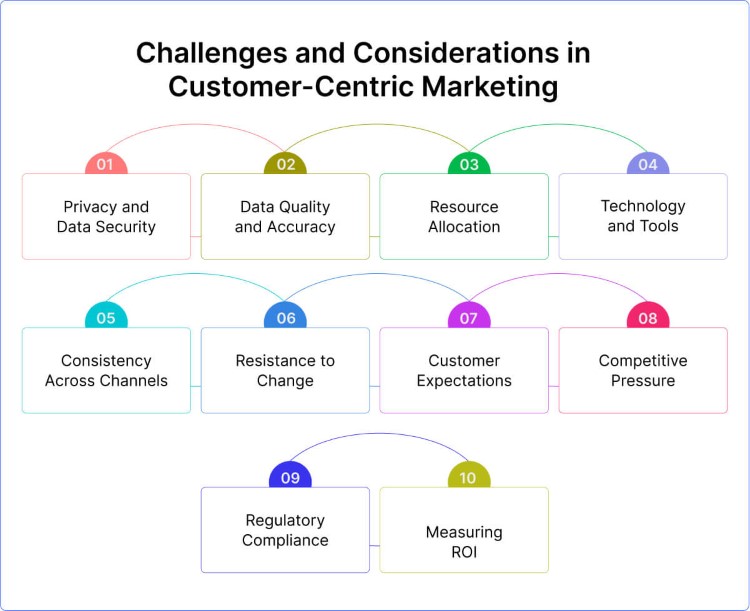
It offers numerous benefits, but it also comes with its set of challenges and considerations that businesses must navigate effectively. Here are some of the key challenges and considerations:
1. Privacy and Data Security
As businesses collect and use customer data to personalize marketing efforts, privacy concerns become paramount. Striking the right balance between personalization and respecting customer privacy is a significant challenge.
2. Data Quality and Accuracy
Customer-centric marketing relies heavily on data. Ensuring data quality, accuracy, and relevance is crucial. Inaccurate data can lead to misguided marketing efforts and customer dissatisfaction.
3. Resource Allocation
Effective customer-centric marketing can be resource-intensive. Businesses must carefully allocate resources to collect and analyze data, develop personalized content, and implement customer feedback mechanisms.
4. Technology and Tools
Implementing the necessary technology and tools to support customer-centric strategies can be complex and costly. Integration challenges and selecting the right software solutions are common hurdles.
5. Consistency Across Channels
Maintaining a consistent customer experience across various touchpoints, such as social media, websites, and physical stores, can be challenging. Inconsistencies can confuse customers and dilute your brand identity.
6. Resistance to Change
Shifting to a customer-centric mindset often requires a cultural shift within the organization. Resistance to change from employees who are accustomed to traditional marketing approaches can be a significant hurdle.
7. Customer Expectations
As customers become more accustomed to personalized experiences, their expectations rise. Meeting or exceeding these expectations consistently can be a challenge.
8. Competitive Pressure
As more businesses adopt customer-centric marketing, the competitive landscape intensifies. Staying ahead of the competition in delivering superior customer experiences becomes increasingly challenging.
9. Regulatory Compliance
Compliance with data protection regulations, such as GDPR or CCPA, is critical. Failure to comply can result in legal repercussions and damage to a company’s reputation.
10. Measuring ROI
Measuring the return on investment (ROI) of customer-centric marketing initiatives can be complex. It may take time to see the full impact on customer retention and revenue.
Conclusion
In a world where customers are more discerning and informed than ever before, customer-centric marketing is not just a choice – it’s a necessity. The businesses that truly understand and prioritize their customers’ needs and desires are the ones poised for success.
They are the brands that create lasting relationships, drive loyalty, and stay ahead of the competition. So, as you venture into the ever-evolving landscape of marketing, remember this: Your customers are the compass that will guide your way.
When you make the shift towards customer-centric marketing, you’re not just promoting a product or service; you’re offering a solution tailored to your customers’ dreams and aspirations.
It’s a win-win for both your business and the people you serve.


